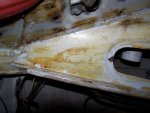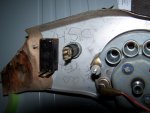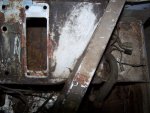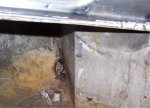
Since my car has obviously never been restored and the data plate has never been removed, I can be reasonably sure that everything is original since all the numbers agree with the data plate. Upon close examination of the car during taredown, it was pretty obvious that the car is 99% original. The only changes that I could find were the brake pads, distributor cap, rotor, plugwires, spark plugs, radiator hoses, waterpump, leather shift knob, interior door handles and window crank handles. The latter three changes appear to be Jaguar dress-up items. The originality of the dashpad is in question.
What doesn't appear on the data plate is the color of the car or the color of its interior. This makes it possible to change the color of the car and still be considered correct as long as the color was available at that time. This leaves it open as to whether or not I should change the color. I have planty of time to decide, but I do know that it will NOT be painted British Racing Green. I do not see many classic Jaguars where I live, but a majority of the ones I see are British Racing Green.







The Body number is also handwritten multiple locations during the assembly process. I have located this number on the right front firewall, top of picture frame (above the fan), inside of the rear hatch, behind the instrument cluster (which also has the interior color written) and the top of the LH bulkhead (which is unusual). The Body Number is also supposed to appear on the underside of the dashpad. On this car the number was different (3741 instead of 4150). This is an indication that either the pad was changed or the factory installed the wrong one. Using the XKEData Website as a reference, I found that body number 3742 was build in late October 1962, while this car was built in early November 1962. So it is possible that the dashpads were mixed up at the factory.



